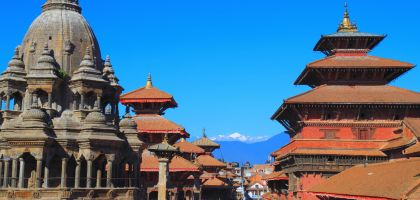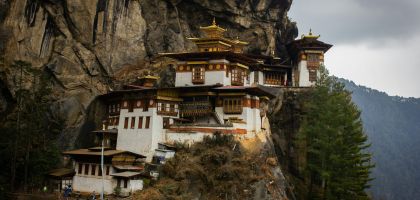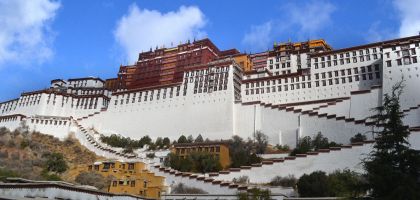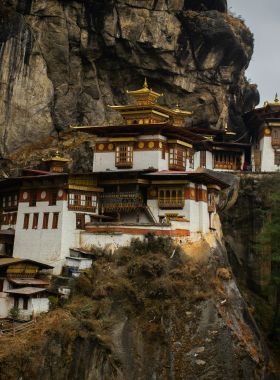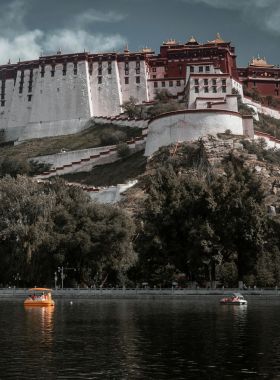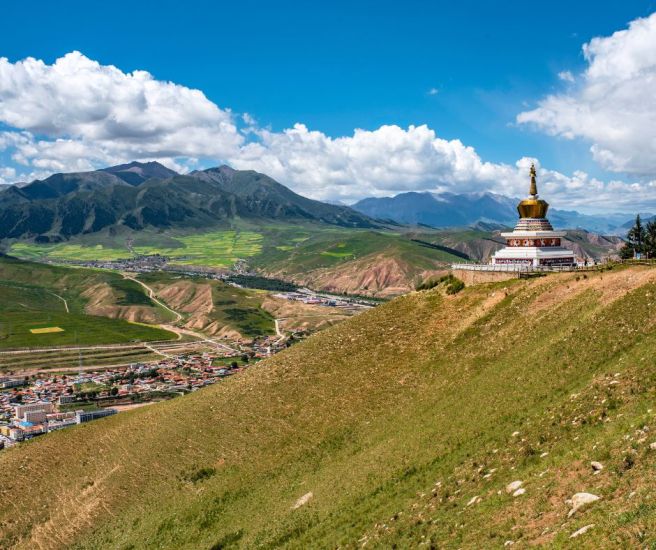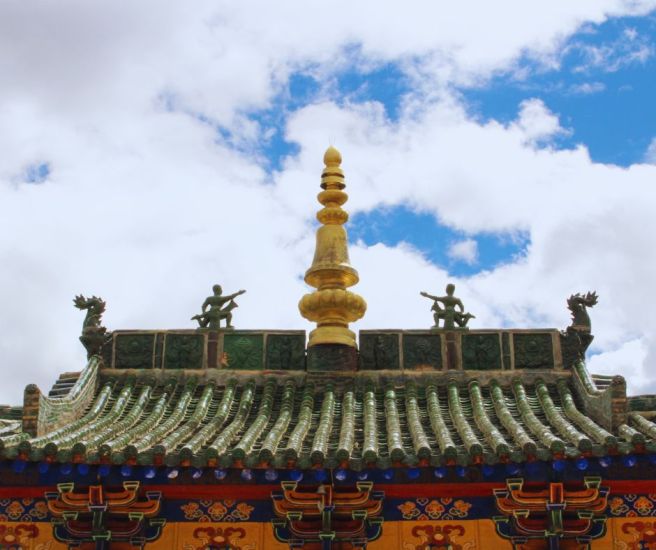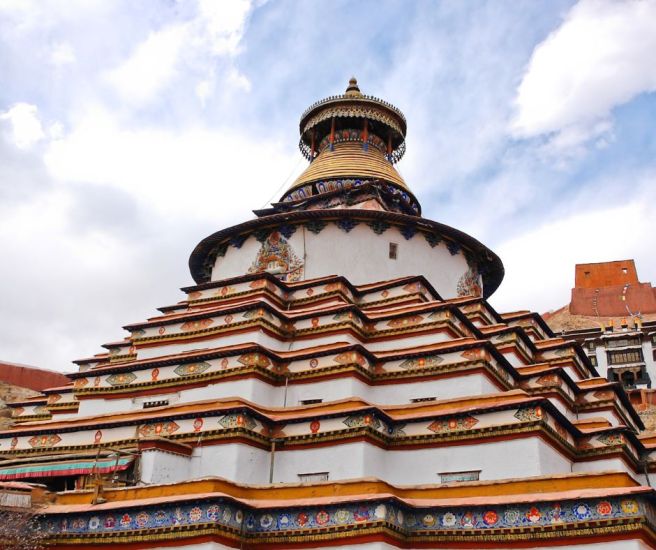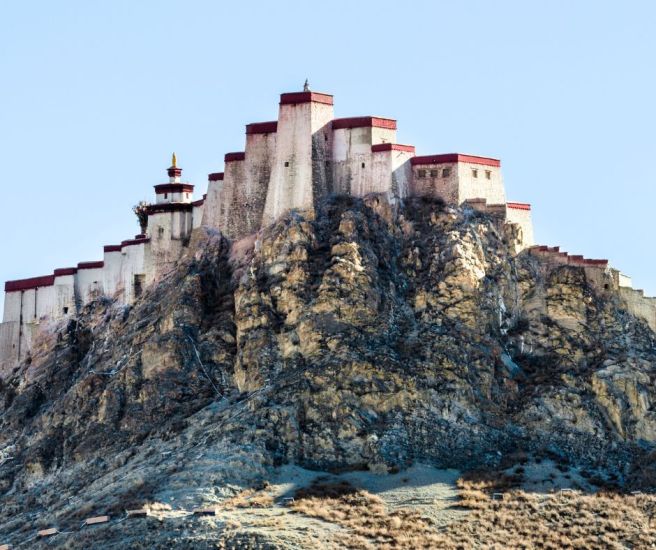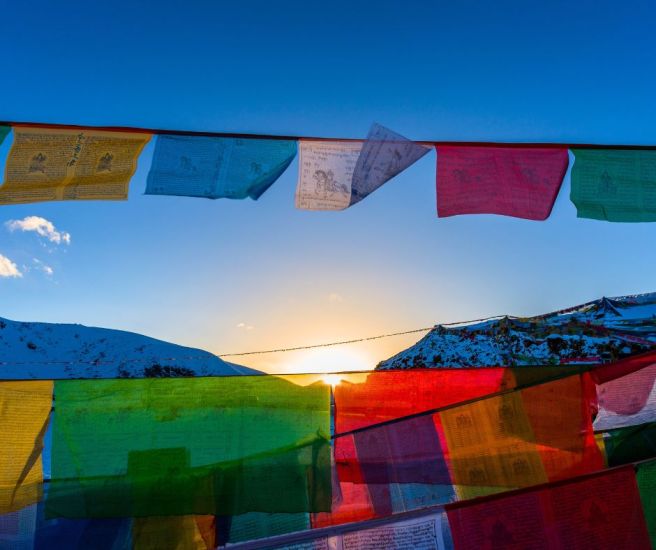Shalu to Nartang Trek
9 Days / Tibet
Activity
Difficulty Level
Destinations
Trip Start / End
Max Altitude
Accommodation
Travel Style
Best time to travel
Personalized Travel Advice

Dev Raj Nepal
+977 9851096523
Detailed Itinerary
01
DAY
01
Arrive at Lhasa’s Gonggar Airport, where you will be warmly greeted by our representative and transferred to the city. Check into your hotel and take the rest of the day to relax and acclimatize to the altitude.
Arrival Lhasa
Arrive at Lhasa’s Gonggar Airport, where you will be warmly greeted by our representative and transferred to the city. Check into your hotel and take the rest of the day to relax and acclimatize to the altitude.
02
DAY
02
Begin your adventure with a full day of sightseeing, immersing yourself in the cultural and spiritual essence of Lhasa. Start at the iconic Potala Palace, a UNESCO World Heritage Site that dominates the skyline and offers sweeping views of the city. Wander through its labyrinthine halls, filled with murals, statues, and treasures that tell the story of Tibet’s spiritual rulers. Continue to Sera Monastery, one of the three great Yellow Sect monasteries of Lhasa, renowned for its scholarly atmosphere and lively debates between monks. End the day at Norbulingka, the stunning summer palace of the Dalai Lama, surrounded by tranquil gardens and serene ponds. Return to your hotel to reflect on the day’s discoveries. Overnight in Lhasa.
Lhasa Exploration
Begin your adventure with a full day of sightseeing, immersing yourself in the cultural and spiritual essence of Lhasa. Start at the iconic Potala Palace, a UNESCO World Heritage Site that dominates the skyline and offers sweeping views of the city. Wander through its labyrinthine halls, filled with murals, statues, and treasures that tell the story of Tibet’s spiritual rulers. Continue to Sera Monastery, one of the three great Yellow Sect monasteries of Lhasa, renowned for its scholarly atmosphere and lively debates between monks. End the day at Norbulingka, the stunning summer palace of the Dalai Lama, surrounded by tranquil gardens and serene ponds. Return to your hotel to reflect on the day’s discoveries. Overnight in Lhasa.
03
DAY
03
The exploration of Lhasa continues today with a visit to Drepung Monastery, once the largest monastery in Tibet and a major center of learning. Wander through its massive courtyards and study the intricate Tibetan architecture. Then, head to the Jokhang Temple, the most revered pilgrimage site in Tibet, where the scent of incense fills the air and pilgrims from all walks of life circle the temple in devotion. Conclude your day with a stroll around the lively Barkhor Street, where the pulse of Lhasa is felt through its bustling shops, prayer wheels, and vibrant market stalls. Return to your hotel for a restful night.
Lhasa Exploration
The exploration of Lhasa continues today with a visit to Drepung Monastery, once the largest monastery in Tibet and a major center of learning. Wander through its massive courtyards and study the intricate Tibetan architecture. Then, head to the Jokhang Temple, the most revered pilgrimage site in Tibet, where the scent of incense fills the air and pilgrims from all walks of life circle the temple in devotion. Conclude your day with a stroll around the lively Barkhor Street, where the pulse of Lhasa is felt through its bustling shops, prayer wheels, and vibrant market stalls. Return to your hotel for a restful night.
04
DAY
04
We begin our journey in the morning, traveling from Lhasa to Shigatse. Along the route, we’ll cross the Gampala Pass (4790 m) and be treated to a breath-taking view of Yamdrok Tso (4400 m), a serene lake surrounded by snow-covered mountains. Far in the distance, the majestic Mount Nyenchen Khangsar (7191 m), the tallest peak near Lhasa, stands proudly.
As we continue, we’ll drive past the impressive Korola Glacier and make a stop at Manak Dam Lake, where you can hang prayer flags at the Simila Mountain Pass. Our next destination is Gyantse, Tibet’s third-largest city, where we’ll explore the famous Pelkor Monastery and the Gyantse Kumbum. From here, we’ll enjoy sweeping views of the historic Gyangtse Fortress.
We then make our way to Shalu Monastery, home to the revered scholar Buton Rinchendrub (1290-1346), a key figure in the translation of Indian Buddhist texts into Tibetan. Close to Shalu, our trekking journey begins. After a short trek, we’ll arrive at a beautiful campsite a few kilometers away, where we’ll settle in for our first night under the stars.
Lhasa – Gyantse – Shalu
We begin our journey in the morning, traveling from Lhasa to Shigatse. Along the route, we’ll cross the Gampala Pass (4790 m) and be treated to a breath-taking view of Yamdrok Tso (4400 m), a serene lake surrounded by snow-covered mountains. Far in the distance, the majestic Mount Nyenchen Khangsar (7191 m), the tallest peak near Lhasa, stands proudly.
As we continue, we’ll drive past the impressive Korola Glacier and make a stop at Manak Dam Lake, where you can hang prayer flags at the Simila Mountain Pass. Our next destination is Gyantse, Tibet’s third-largest city, where we’ll explore the famous Pelkor Monastery and the Gyantse Kumbum. From here, we’ll enjoy sweeping views of the historic Gyangtse Fortress.
We then make our way to Shalu Monastery, home to the revered scholar Buton Rinchendrub (1290-1346), a key figure in the translation of Indian Buddhist texts into Tibetan. Close to Shalu, our trekking journey begins. After a short trek, we’ll arrive at a beautiful campsite a few kilometers away, where we’ll settle in for our first night under the stars.
05
DAY
05
After breakfast at the camp, we begin our trek towards Upper Lungsang, situated at an altitude of 4,060 meters above sea level. Along the way, we will pass several interesting landmarks, including the Ripu Hermitage, a peaceful retreat nestled in the mountains. We will also traverse a floodplain, where the vastness of the Tibetan landscape unfolds before us, and continue through Phunup Village, offering a glimpse into rural Tibetan life. As we make our way towards the Showa-La Pass, we’ll gain an understanding of how local Tibetans live, farming the land and practicing their Buddhist traditions in the peaceful countryside.
Upon arrival at Upper Lungsang, we set up camp for the night, where you can unwind and take in the surrounding beauty of the Tibetan highlands.
Shalu – Upper Lungsang
After breakfast at the camp, we begin our trek towards Upper Lungsang, situated at an altitude of 4,060 meters above sea level. Along the way, we will pass several interesting landmarks, including the Ripu Hermitage, a peaceful retreat nestled in the mountains. We will also traverse a floodplain, where the vastness of the Tibetan landscape unfolds before us, and continue through Phunup Village, offering a glimpse into rural Tibetan life. As we make our way towards the Showa-La Pass, we’ll gain an understanding of how local Tibetans live, farming the land and practicing their Buddhist traditions in the peaceful countryside.
Upon arrival at Upper Lungsang, we set up camp for the night, where you can unwind and take in the surrounding beauty of the Tibetan highlands.
06 – 07
DAY
06 – 07
Moving out of Upper Lungsang, the trail will take us across the valley towards Char La. It’s a rather barren terrain with a ravine below. After walking for about three hours, we reach the Char La pass, at 4600m. From Char La, we make a gradual descent of one hour to reach Ngor Monastery. This monastery was built in the year 1429 by Ngorchen Kunga Sangpo and contains a Sanskrit library and beautiful murals influenced by Newari artistry. We will camp close by for the night. From Ngor, we walk to the village of Pero. Crossing the village of Dzong Lugari, an hour later, we will keep walking towards Nartang, which will take a couple of hours. At Nartang, we will drive to Shigatse. Stay overnight at a hotel in Shigatse.
Upper Lungsang – Ngor – Nartang-Shigatse
Moving out of Upper Lungsang, the trail will take us across the valley towards Char La. It’s a rather barren terrain with a ravine below. After walking for about three hours, we reach the Char La pass, at 4600m. From Char La, we make a gradual descent of one hour to reach Ngor Monastery. This monastery was built in the year 1429 by Ngorchen Kunga Sangpo and contains a Sanskrit library and beautiful murals influenced by Newari artistry. We will camp close by for the night. From Ngor, we walk to the village of Pero. Crossing the village of Dzong Lugari, an hour later, we will keep walking towards Nartang, which will take a couple of hours. At Nartang, we will drive to Shigatse. Stay overnight at a hotel in Shigatse.
08
DAY
08
Today we will visit the Tashilhunpo monastery in Shigatse. This is the seat of the spiritual leader, Panchan Lama, and is therefore, extremely significant to the Tibetans. Tashilhunpo is also renowned for the tallest Jampa Buddha (Maitreya Buddha) statue in the world. This bronze statue stands 26.2 meters high and is adorned with more than 1,400 precious ornaments such as pearls, diamonds, and corals.
Later, taking the Friendship Highway, we will drive to Lhasa. The drive, which will take 6 hours, is absolutely scenic. We reach Lhasa, and stay overnight at a hotel.
Shigatse – Lhasa
Today we will visit the Tashilhunpo monastery in Shigatse. This is the seat of the spiritual leader, Panchan Lama, and is therefore, extremely significant to the Tibetans. Tashilhunpo is also renowned for the tallest Jampa Buddha (Maitreya Buddha) statue in the world. This bronze statue stands 26.2 meters high and is adorned with more than 1,400 precious ornaments such as pearls, diamonds, and corals.
Later, taking the Friendship Highway, we will drive to Lhasa. The drive, which will take 6 hours, is absolutely scenic. We reach Lhasa, and stay overnight at a hotel.
09
DAY
09
After breakfast, you will be transferred to the airport for departure.
Departure
After breakfast, you will be transferred to the airport for departure.
Includes / Excludes
Inclusions
-
All necessary Tibet travel Permit and trekking permit
-
Tibet Group Visa
-
Sightseeing and Entrance fee as per the Itinerary
-
Food on Full board Basis during Trekking
-
Accommodation in Hotel / Guest houses
-
Yaks & yak Man during Trekking while trekking depend on Trekking
-
Private Transportation
-
English speaking local Guide
Exclusions
-
Insurance of any kind
-
Hiring porter or Horse
-
Personal trekking equipment
-
Rescue and Evacuation Service
-
Any Additional cost due to Nature calamity and Unforeseen Circumstances and etc
Trip Info
Spring (April – June)
From May to June, temperatures range from 5°C to 18°C (41°F to 64°F) during the day, while nights can drop to -2°C to 5°C (28°F to 41°F) at higher altitudes. The skies are generally clear, offering excellent visibility of the surrounding landscapes. The terrain begins to turn lush and green after the winter, making for a refreshing trekking experience. This period also sees fewer crowds, allowing for a more peaceful journey through Tibet’s remote highlands.
Summer (July – August)
During the summer months, daytime temperatures remain pleasant, ranging from 10°C to 22°C (50°F to 72°F), while nights are relatively mild, averaging 0°C to 8°C (32°F to 46°F). The trails are at their most vibrant, with blooming wildflowers and lush valleys. While Tibet is in the rain shadow of the Himalayas, occasional light rainfall may occur, though it rarely disrupts trekking plans.
Early Autumn (September – October)
September and October offer the most stable weather for trekking. Daytime temperatures range from 5°C to 17°C (41°F to 63°F), while nights can be quite cold, dropping to -5°C to 3°C (23°F to 37°F), especially in higher camps. The air is crisp, and the mountain views are exceptionally clear. The surrounding landscapes take on golden hues, creating a stunning contrast against the deep blue skies. While days are comfortable for trekking, proper gear is essential for the colder nights.
You will be transferred to Lhasa in a private vehicle, typically a 4×4 SUV or minibus, depending on the group size. These vehicles are specifically chosen for their ability to handle the rugged mountain roads, ensuring a smooth and comfortable journey to your hotel in Lhasa. All transfers during the trip are conducted in reliable, high-altitude vehicles designed to navigate Tibet’s challenging terrain with both safety and comfort in mind.
The vehicles are carefully selected to withstand the unpredictable nature of Tibet’s roads, particularly in high-altitude and remote areas. They are equipped with proper suspension to provide a stable ride over uneven terrain. Additionally, all vehicles offer air conditioning or heating, ensuring comfort in any season.
Throughout this Tibet tour, we have carefully selected a range of comfortable accommodations to ensure you experience a blend of Tibetan culture and modern amenities.
Hotels: In cities like Lhasa and Shigatse, you will stay in well-appointed hotels that offer a cozy retreat after your day of exploration. These hotels are equipped with essential facilities like warm showers, comfortable beds, and Wi-Fi access in select areas, allowing you to rest and recharge. The warm Tibetan hospitality will make you feel right at home.
Camping: During your trekking days, you’ll enjoy camping in scenic spots surrounded by nature. Each campsite is carefully selected for its tranquility and stunning views. Comfortable tents and basic camping amenities will be provided, ensuring you have a restful night amidst the serene Tibetan plateau. These campsites offer the perfect opportunity to connect with nature, away from the hustle and bustle of city life.
Tibetan cuisine is hearty and designed to keep you energized at high altitudes. You’ll savor traditional dishes like tsampa (roasted barley flour), momos (steamed dumplings), and thukpa (noodle soup), along with yak meat stews that are staples of local meals. On trekking days, expect simple yet filling meals, including rice, vegetables, and meat, as well as hot soups and momos to keep you fueled throughout the journey.
International meal options are available at hotels, including pasta, rice dishes, and salads, catering to various preferences. Traditional Tibetan butter tea, herbal teas, and coffee are commonly served, offering warmth and comfort. As you explore local markets, you’ll have the chance to try snacks like fresh fruit, nuts, and Tibetan sweets, adding a delightful touch to your culinary experience.
Clothing:
- Warm layers (thermal base layers, fleece jacket, down jacket)
- Waterproof and windproof jacket
- Trekking pants and shorts
- Comfortable walking shoes/boots
- Sandals or flip-flops for accommodations
- Hat, gloves, and scarf
- Sun hat or cap
- Lightweight, breathable clothing for warmer days
- Socks (preferably moisture-wicking)
- Sunglasses (with UV protection)
Trekking Gear:
- Daypack (for daily hikes and treks)
- Lightweight towel
- Water bottle or hydration system
- Personal first aid kit (including blister care, pain relievers, etc.)
- Sunblock (SPF 30 or higher)
- Lip balm with sun protection
Travel Essentials:
- Passport and visa (with photocopies)
- Travel insurance details
- Camera and extra memory cards/batteries
- Power bank and charger (portable)
- Flashlight or headlamp
- Personal hygiene items (toothbrush, toothpaste, etc.)
- Wet wipes or hand sanitizer
- Toilet paper and tissues
- Ziploc bags (for keeping electronics and documents dry)
Scenic Beauty
Prepare to be surrounded by some of the most breathtaking vistas on Earth. From the snow-capped peaks of the Himalayas to the tranquil Yamdrok Tso Lake, the views will leave you speechless. The high-altitude landscapes, including expansive valleys, rolling plains, and rugged mountain passes, offer a truly immersive experience in the Tibetan wilderness during your trekking in Tibet.
Cultural Exploration
Tibet is a land steeped in rich history and spiritual significance. You’ll visit iconic sites like the Potala Palace, Jokhang Temple, and Drepung Monastery, each offering a glimpse into Tibet’s ancient culture and religious practices. The vibrant markets of Barkhor Street and the scholarly debates at Sera Monastery further enrich your cultural journey. This combination of cultural immersion and trekking in Tibet makes for a truly unique experience.
Trekking Adventure
Over several days, you’ll trek through remote Tibetan villages and high-altitude trails. Expect challenging yet rewarding treks through rugged terrain, where you’ll pass serene hermitages, ancient monasteries, and vast floodplains. The higher you go, the more rewarding the views and the closer you get to understanding the nomadic lifestyle of the Tibetan people, all while trekking in Tibet’s majestic mountains.
Spiritual Immersion
Tibet is known for its deep spiritual traditions, and you’ll feel its presence everywhere—from the scent of incense in the Jokhang Temple to the powerful mantras recited by monks in the monasteries. Whether it’s visiting sacred sites or observing the daily routines of pilgrims, you’ll experience a culture where faith and nature are closely intertwined with your trekking in Tibet adventure.
Local Interaction
As you explore the Tibetan countryside, you’ll have opportunities to interact with local people, including farmers, monks, and nomads. These encounters will offer a rare glimpse into the traditional Tibetan way of life, rooted in Buddhism and their deep connection to the land, especially as you trek through remote areas.
Altitude & Acclimatization
Due to the high-altitude nature of trekking in Tibet, be prepared for the effects of altitude. You’ll have plenty of time to acclimatize in Lhasa, and our team will guide you through the necessary precautions. With proper acclimatization, you’ll be ready to enjoy the adventure ahead, trekking safely in the Tibetan highlands.
FAQs
Personalized Travel Advice

Dev Raj Nepal
+977 9851096523
